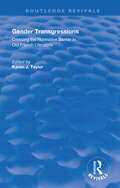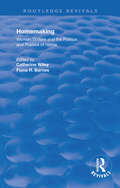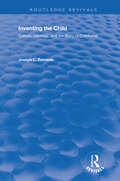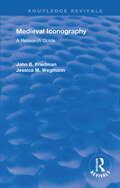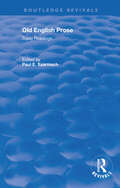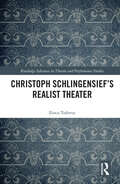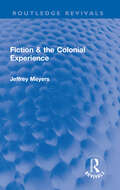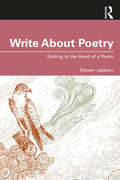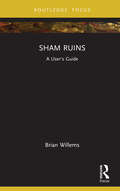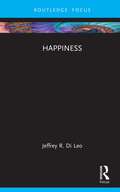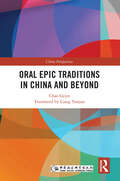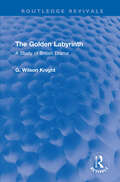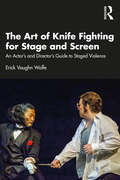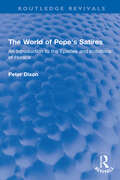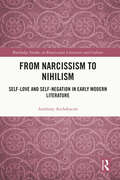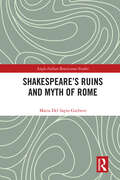- Table View
- List View
Gender Transgressions: Crossing the Normative Barrier in Old French Literature (Garland Library Of Medieval Literature Ser.)
by Karen J. TaylorFirst published in 1998 this collection, comprising nine critical essays from prominent and emerging medievalists, seeks to explore the different ways in which French authors of the Middle Ages transgress normative social and cultural codes in their literary works.
Homemaking: Women Writers and the Politics and Poetics of Home
by Catherine Wiley Fiona R. BarnesFirst published in 1996. The present volume, Homemaking: Women Writers and the Politics and Poetics of Home, enters the critical discourse on gender by way of two of its most pressing issues: the politics of women’s locations at the end of the twentieth century, and the division of experience into public and private. That the emergence of systematic feminist thought in the west coincided with the invention of "private life" should not surprise us. Feminist thinkers from Mary Wollstonecroft on were quick to realize that the designation of the public and the private, male and female, was key to the subordination of women.
Inventing the Child: Culture, Ideology and the Story of the Child
by Joseph L. ZornadoThis book traces the historical roots of Western culture's stories of childhood in which the child is subjugated to the adult. Going back 400 years, it looks again at Hamlet, fairy tales of the Brothers Grimm, and Walt Disney cartoons. Inventing the Child is a highly entertaining, humorous, and at times acerbic account of what it means to be a child (and a parent) in America at the dawn of the new millennium. John Zornado explores the history and development of the concept of childhood, starting with the works of Calvin, Freud, and Rousseau and culminating with the modern "consumer" childhood of Dr. Spock and television. The volume discusses major media depictions of childhood and examines the ways in which parents use different forms of media to swaddle, educate, and entertain their children. Zornado argues that the stories we tell our children contain the ideologies of the dominant culture--which, more often than not, promote "happiness" at all costs, materialism as the way to happiness, and above all, obedience to the dominant order.
Medieval Iconography: A Research Guide
by John B. Friedman and Jessica M. WegmannFirst published in 1998, the present volume aims to help the researcher locate visual motifs, whether in medieval art or in literature, and to understand how they function in yet other medieval literary or artistic works.
Old English Prose: Basic Readings
by Paul E. Szarmach and Deborah A. OosterhouseFirst published in 2001. With the decline of formalism and its predilection for Old English poetry, Old English prose is leaving the periphery and moving into the center of literary and cultural discussion. The extensive corpus of Old English prose lends many texts of various kinds to the current debates over literary theory and its multiple manifestations. The purpose of this collection is to assist the growing interest in Old English prose by providing essays that help establish the foundations for considered study and offer models and examples of special studies. Both retrospective and current in its examples, this collection can serve as a "first book" for an introduction to study, particularly suitable for courses that seek to entertain such issues as authorship, texts and textuality, source criticism, genre, and forms of historical criticism as a significant part of a broad, cultural teaching (and research) plan.
Christoph Schlingensief's Realist Theater (Routledge Advances in Theatre & Performance Studies)
by Ilinca TodorutThis book is the first study of the prolific German filmmaker, performance artist, and TV host Christoph Schlingensief (1960–2010) that identifies him as a practitioner of realism in the theater and lays out how theatrical realism can offer an aesthetic frame sturdy enough to hold together his experiments across media and genres. This volume traces Schlingensief’s developing realism through his theater work in conventional theater venues, in less conventional venues, his opera work focusing on the production of Wagner’s Parsifal at Bayreuth, and his art installations on revolving platforms called Animatographs. This book will be of great interest to scholars of theater, film, and performance art and practitioners.
Christoph Schlingensief's Realist Theater (Routledge Advances in Theatre & Performance Studies)
by Ilinca TodorutThis book is the first study of the prolific German filmmaker, performance artist, and TV host Christoph Schlingensief (1960–2010) that identifies him as a practitioner of realism in the theater and lays out how theatrical realism can offer an aesthetic frame sturdy enough to hold together his experiments across media and genres. This volume traces Schlingensief’s developing realism through his theater work in conventional theater venues, in less conventional venues, his opera work focusing on the production of Wagner’s Parsifal at Bayreuth, and his art installations on revolving platforms called Animatographs. This book will be of great interest to scholars of theater, film, and performance art and practitioners.
Fiction & the Colonial Experience (Routledge Revivals)
by Jeffrey MeyersBritish colonialism provided a rich vein of material for the novelists of the first half of the 20th century. This study, originally published in 1968, looks at five writers and their reaction to the Empire: Rudyard Kipling, E. M. Forster, Joseph Conrad, Joyce Cary and Graham Greene. It shows how the romantic adventure stories of Kipling’s early days, in which the indigenous population plays almost no part, gave rise to the much more important novels of spiritual and moral conflict in which the stereotyped values of Empire are questioned. The decline of colonialism from its apogee in the 1880s within a relatively short period makes the novels discussed a compact group, so that not only is the use of colonial material closely studied, but its impact on the novelists themselves emerges clearly. This is an important study of a major literary theme, linking modern literature and modern history at a vital point.
Fiction & the Colonial Experience (Routledge Revivals)
by Jeffrey MeyersBritish colonialism provided a rich vein of material for the novelists of the first half of the 20th century. This study, originally published in 1968, looks at five writers and their reaction to the Empire: Rudyard Kipling, E. M. Forster, Joseph Conrad, Joyce Cary and Graham Greene. It shows how the romantic adventure stories of Kipling’s early days, in which the indigenous population plays almost no part, gave rise to the much more important novels of spiritual and moral conflict in which the stereotyped values of Empire are questioned. The decline of colonialism from its apogee in the 1880s within a relatively short period makes the novels discussed a compact group, so that not only is the use of colonial material closely studied, but its impact on the novelists themselves emerges clearly. This is an important study of a major literary theme, linking modern literature and modern history at a vital point.
Write About Poetry: Getting to the Heart of a Poem
by Steven JacksonHow do we read poetry, compare poems, or generate observations into a thoughtful response? Write About Poetry is an invaluable reference book and skills guide for students of poetry. Featuring model essays, a glossary of technical terms, and additional practice for student engagement, this volume provides students with a clear and concise guide to: • reading unseen poems with confidence • developing general observations into formal, structured written responses • fostering familiarity with some of the great poets and poems in literary history Drawing on years of teaching experience, Steven Jackson delivers the background, progressive methodology, and practical essay writing techniques essential for understanding the fundamental steps of poetry analysis.
Write About Poetry: Getting to the Heart of a Poem
by Steven JacksonHow do we read poetry, compare poems, or generate observations into a thoughtful response? Write About Poetry is an invaluable reference book and skills guide for students of poetry. Featuring model essays, a glossary of technical terms, and additional practice for student engagement, this volume provides students with a clear and concise guide to: • reading unseen poems with confidence • developing general observations into formal, structured written responses • fostering familiarity with some of the great poets and poems in literary history Drawing on years of teaching experience, Steven Jackson delivers the background, progressive methodology, and practical essay writing techniques essential for understanding the fundamental steps of poetry analysis.
Sham Ruins: A User's Guide (Routledge Focus on Literature)
by Brian WillemsIn the middle of the eigtheenth century, a new fad found its way into the gardens of England's well-to-do: building fake Gothic ruins. Newly constructed castle towers and walls looked like they were already falling apart, even on the first day of their creation. Made of stone, plaster, or even canvas, these "sham ruins" are often considered an embarrassing blip in English architectural history. However, Sham Ruins: A User's Guide expands the specific example of the sham ruin into a general principle to examine the way purposely broken objects can be used to both uncover old truths and invent new ones. Along with architecture, work by Ivan Vladislavić, Tom Stoppard, Alain Mabanckou, Aleksei Fedorchenko, Michael Haneke, and Sturtevant is used to develop this thesis, as well as artifacts such as pre-torn jeans, fake histories, and broken screen apps. Using these examples, one of the key questions the book raises is: what is it that sham ruins ruin? In other words, if real ruins are ruins of what they actually are, then sham ruins should be considered ruins of what they are not. Thus sham ruins are about imposing new meaning where such meaning does not and should not exist. They also can show how things we think are functioning well are actually already broken. Sham ruins do this, and much more, by being lies, ruses, and embarrassments. This is what gives them the power with which we can think about objects in new, unintended ways.
Sham Ruins: A User's Guide (Routledge Focus on Literature)
by Brian WillemsIn the middle of the eigtheenth century, a new fad found its way into the gardens of England's well-to-do: building fake Gothic ruins. Newly constructed castle towers and walls looked like they were already falling apart, even on the first day of their creation. Made of stone, plaster, or even canvas, these "sham ruins" are often considered an embarrassing blip in English architectural history. However, Sham Ruins: A User's Guide expands the specific example of the sham ruin into a general principle to examine the way purposely broken objects can be used to both uncover old truths and invent new ones. Along with architecture, work by Ivan Vladislavić, Tom Stoppard, Alain Mabanckou, Aleksei Fedorchenko, Michael Haneke, and Sturtevant is used to develop this thesis, as well as artifacts such as pre-torn jeans, fake histories, and broken screen apps. Using these examples, one of the key questions the book raises is: what is it that sham ruins ruin? In other words, if real ruins are ruins of what they actually are, then sham ruins should be considered ruins of what they are not. Thus sham ruins are about imposing new meaning where such meaning does not and should not exist. They also can show how things we think are functioning well are actually already broken. Sham ruins do this, and much more, by being lies, ruses, and embarrassments. This is what gives them the power with which we can think about objects in new, unintended ways.
Happiness (New Literary Theory)
by Jeffrey R. Di LeoThis book introduces the reader to the ways in which happiness has been explored in philosophy and literature for thousands of years, in order to understand the newest theoretical approaches to happiness. Jeffrey R. Di Leo draws on its long and rich history as a window into our present obsession with happiness. Each of the four chapters of this book provides a substantially different literary-theoretical account of how and why literature matters with respect to considerations of happiness. From the neoliberal happiness industry and the psychoanalytic rejection of happiness to aesthetic hedonism and revolutionary happiness, literature viewed from the perspective of happiness becomes a story about what is and is not the goal of life. The multidisciplinary approach of this book will appeal to a variety of readers from literary studies, critical theory, philosophy and psychology and anyone with an interest in happiness and theories of emotion.
Happiness (New Literary Theory)
by Jeffrey R. Di LeoThis book introduces the reader to the ways in which happiness has been explored in philosophy and literature for thousands of years, in order to understand the newest theoretical approaches to happiness. Jeffrey R. Di Leo draws on its long and rich history as a window into our present obsession with happiness. Each of the four chapters of this book provides a substantially different literary-theoretical account of how and why literature matters with respect to considerations of happiness. From the neoliberal happiness industry and the psychoanalytic rejection of happiness to aesthetic hedonism and revolutionary happiness, literature viewed from the perspective of happiness becomes a story about what is and is not the goal of life. The multidisciplinary approach of this book will appeal to a variety of readers from literary studies, critical theory, philosophy and psychology and anyone with an interest in happiness and theories of emotion.
Oral Epic Traditions in China and Beyond (China Perspectives)
by Chao GejinThis volume is the masterpiece of Chao Gejin, one of the best-known Chinese scholars of Epic studies, representing his most influential works on the change of the nature of the Epic across the twentieth century. The discussion ranges from Homeric and Indo-European epics to renewed discoveries of age-old African and Asian epics. The author details developments in research from Parry and Lord’s work on Serbo-Croat oral poetry to his own research on the Mongol heroic epic. The book traces the formation of theoretical systems such as Oral Formulaic Theory, Ethnopoetics and Performance Theory, and ends with the author’s explorations of the 20th-century Mongolian bard Arimpil’s singing of his native epic poetry. Using methods that previous scholars used to demonstrate the fundamentally oral nature of the Homeric epic, Chao brings to light the poetic richness of the still-living Mongol oral epic tradition. Students and scholars of epic studies, literature, folklore and anthropology will find this an essential reference.
Oral Epic Traditions in China and Beyond (China Perspectives)
by Chao GejinThis volume is the masterpiece of Chao Gejin, one of the best-known Chinese scholars of Epic studies, representing his most influential works on the change of the nature of the Epic across the twentieth century. The discussion ranges from Homeric and Indo-European epics to renewed discoveries of age-old African and Asian epics. The author details developments in research from Parry and Lord’s work on Serbo-Croat oral poetry to his own research on the Mongol heroic epic. The book traces the formation of theoretical systems such as Oral Formulaic Theory, Ethnopoetics and Performance Theory, and ends with the author’s explorations of the 20th-century Mongolian bard Arimpil’s singing of his native epic poetry. Using methods that previous scholars used to demonstrate the fundamentally oral nature of the Homeric epic, Chao brings to light the poetic richness of the still-living Mongol oral epic tradition. Students and scholars of epic studies, literature, folklore and anthropology will find this an essential reference.
The Golden Labyrinth: A Study of British Drama (Routledge Revivals)
by G. Wilson KnightFirst published in 1965, The Golden Labyrinth provides a coherent and readable history of the essential nature of British drama in a single volume. The treatment is philosophical and imaginative, and full of enthusiasm and clarity which have made Professor Wilson Knight’s works, of Shakespearian and other interpretations, so famous. The chapters in this book have been organized according to literary periods and will appeal to both students of literature and casual readers.
The Golden Labyrinth: A Study of British Drama (Routledge Revivals)
by G. Wilson KnightFirst published in 1965, The Golden Labyrinth provides a coherent and readable history of the essential nature of British drama in a single volume. The treatment is philosophical and imaginative, and full of enthusiasm and clarity which have made Professor Wilson Knight’s works, of Shakespearian and other interpretations, so famous. The chapters in this book have been organized according to literary periods and will appeal to both students of literature and casual readers.
The Art of Knife Fighting for Stage and Screen: An Actor’s and Director’s Guide to Staged Violence
by Erick Vaughn WolfeThe Art of Knife Fighting for Stage and Screen: An Actor’s and Director’s Guide to Staged Violence provides detailed information for the safe use of knives and daggers in a theatrical setting and an in-depth understanding of safe theatrical weapons. The book starts with an extensive safety review, then moves on to the basic techniques of dagger fighting, starting with grip and body postures. Readers will then learn about the basic actions of cuts, parries, blocks, and disarms. During this process, they will explore the connection between body and weapon and start learning the elements of storytelling through choreography. Special attention is given to suicides, threats, and murder and how directors, choreographers, performers, teachers, and students can approach these techniques in a way that is physically and mentally safe. The book also covers the use of throwing knives, knife flips, and other tricks to help add a little flair to your fight. The Art of Knife Fighting for Stage and Screen teaches the safe theatrical use of the knife for directors, performers, educators, and students of stage combat.
The Art of Knife Fighting for Stage and Screen: An Actor’s and Director’s Guide to Staged Violence
by Erick Vaughn WolfeThe Art of Knife Fighting for Stage and Screen: An Actor’s and Director’s Guide to Staged Violence provides detailed information for the safe use of knives and daggers in a theatrical setting and an in-depth understanding of safe theatrical weapons. The book starts with an extensive safety review, then moves on to the basic techniques of dagger fighting, starting with grip and body postures. Readers will then learn about the basic actions of cuts, parries, blocks, and disarms. During this process, they will explore the connection between body and weapon and start learning the elements of storytelling through choreography. Special attention is given to suicides, threats, and murder and how directors, choreographers, performers, teachers, and students can approach these techniques in a way that is physically and mentally safe. The book also covers the use of throwing knives, knife flips, and other tricks to help add a little flair to your fight. The Art of Knife Fighting for Stage and Screen teaches the safe theatrical use of the knife for directors, performers, educators, and students of stage combat.
The World of Pope's Satires: An Introduction to the Epistles and Imitations of Horace (Routledge Revivals)
by Peter DixonFirst published in 1968, The World of Pope’s Satires is a stimulating and challenging book showing how the satires written by Pope during the 1730s were not only expressions of his own .poetic personality but were also responsive to the habits and attitudes of the age. The author considers Pope’s uses of some current conversational technique (especially that of ‘raillery’) and of the closely related social ideal of the cultivated gentleman. Pope’s regard for certain personal attributes and moral values – notably hospitality, integrity, friendship, charity and self-knowledge – is examined in two ways; as it expresses itself positively in the satires, and as it is defined negatively by his antipathy towards courtly self-seeking and hypocrisy, contemporary manifestations of acquisitiveness, and the pride associated with neo-stoicism. The final chapter is wide ranging and shows that although Pope is at times representative, and therefore limited, in his response to the pressures and uncertainties of the age, his satires live because of the subtlety of his treatment of such Augustan commonplaces as Order and Balance and the passion and spirit of his writing. This will be an interesting read for students of English literature.
The World of Pope's Satires: An Introduction to the Epistles and Imitations of Horace (Routledge Revivals)
by Peter DixonFirst published in 1968, The World of Pope’s Satires is a stimulating and challenging book showing how the satires written by Pope during the 1730s were not only expressions of his own .poetic personality but were also responsive to the habits and attitudes of the age. The author considers Pope’s uses of some current conversational technique (especially that of ‘raillery’) and of the closely related social ideal of the cultivated gentleman. Pope’s regard for certain personal attributes and moral values – notably hospitality, integrity, friendship, charity and self-knowledge – is examined in two ways; as it expresses itself positively in the satires, and as it is defined negatively by his antipathy towards courtly self-seeking and hypocrisy, contemporary manifestations of acquisitiveness, and the pride associated with neo-stoicism. The final chapter is wide ranging and shows that although Pope is at times representative, and therefore limited, in his response to the pressures and uncertainties of the age, his satires live because of the subtlety of his treatment of such Augustan commonplaces as Order and Balance and the passion and spirit of his writing. This will be an interesting read for students of English literature.
From Narcissism to Nihilism: Self-Love and Self-Negation in Early Modern Literature (Routledge Studies in Renaissance Literature and Culture)
by Anthony ArchdeaconThis book explores how the myth of Narcissus, which is at once about self-love and self-destruction, desire and death, beauty and pain, became an ambivalent symbol of humanistic endeavour, and articulated the conflicts of early modern authorship. In early modern literature, there were expressions of humanistic self-congratulation that sometimes verged on narcissism, and at the same time expressions of self-doubt and anxiety that verged on nihilism. The themes of self-love and self-negation had a long history in western thought, and this book shows how the medieval treatments of the themes developed into something distinctive in the sixteenth century. The two themes, either individually or combined, encompass such topics as poverty, unrequited love, transgressive sexuality, sexual violence, suicidality, self-worth, authorship, religious penitence, martyrdom, courtly ambition and tyranny. Archdeacon uses over 100 texts from the sixteenth and early seventeenth centuries to show how the early modern writer existed in a culture of contrary forces pulling towards either self-affirmation or self-erasure. Writers attempted to negotiate between the polarised extremes of self-love and self-negation, realising that they are fundamental to how we respond to each other, our selves and the world.
Shakespeare’s Ruins and Myth of Rome (Anglo-Italian Renaissance Studies)
by Maria Del Sapio GarberoRome was tantamount to its ruins, a dismembered body, to the eyes of those – Italians and foreigners – who visited the city in the years prior to or encompassing the lengthy span of the Renaissance. Drawing on the double movement of archaeological exploration and creative reconstruction entailed in the humanist endeavour to ‘resurrect’ the past, ‘ruins’ are seen as taking precedence over ‘myth’, in Shakespeare’s Rome. They are assigned the role of a heuristic model, and discovered in all their epistemic relevance in Shakespeare’s dramatic vision of history and his negotiation of modernity. This is the first book of its kind to address Shakespeare’s relationship with Rome’s authoritative myth, archaeologically, by taking as a point of departure a chronological reversal, namely the vision of the ‘eternal’ city as a ruinous scenario and hence the ways in which such a layered, ‘silent’, and aporetic scenario allows for an archaeo-anatomical approach to Shakespeare’s Roman works.
